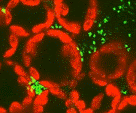Plant Pathology, Department of

Department of Plant Pathology: Faculty Publications
Document Type
Article
Date of this Version
9-4-2013
Citation
Scully ED, Geib SM, Hoover K, Tien M, Tringe SG, et al. (2013)
Abstract
The Asian longhorned beetle (Anoplophora glabripennis) is an invasive, wood-boring pest that thrives in the heartwood of deciduous tree species. A large impediment faced by A. glabripennis as it feeds on woody tissue is lignin, a highly recalcitrant biopolymer that reduces access to sugars and other nutrients locked in cellulose and hemicellulose. We previously demonstrated that lignin, cellulose, and hemicellulose are actively deconstructed in the beetle gut and that the gut harbors an assemblage of microbes hypothesized to make significant contributions to these processes. While lignin degrading mechanisms have been well characterized in pure cultures of white rot basidiomycetes, little is known about such processes in microbial communities associated with wood-feeding insects. The goals of this study were to develop a taxonomic and functional profile of a gut community derived from an invasive population of larval A. glabripennis collected from infested host trees and to identify genes that could be relevant for the digestion of woody tissue and nutrient acquisition. To accomplish this goal, we taxonomically and functionally characterized the A. glabripennis midgut microbiota through amplicon and shotgun metagenome sequencing and conducted a large-scale comparison with the metagenomes from a variety of other herbivoreassociated communities. This analysis distinguished the A. glabripennis larval gut metagenome from the gut communities of other herbivores, including previously sequenced termite hindgut metagenomes. Genes encoding enzymes were identified in the A. glabripennis gut metagenome that could have key roles in woody tissue digestion including candidate lignin degrading genes (laccases, dye-decolorizing peroxidases, novel peroxidases and β- etherases), 36 families of glycoside hydrolases (such as cellulases and xylanases), and genes that could facilitate nutrient recovery, essential nutrient synthesis, and detoxification. This community could serve as a reservoir of novel enzymes to enhance industrial cellulosic biofuels production or targets for novel control methods for this invasive and highly destructive insect.


Comments
PLOS ONE | www.plosone.org September 2013 | Volume 8 | Issue 9 | e73827